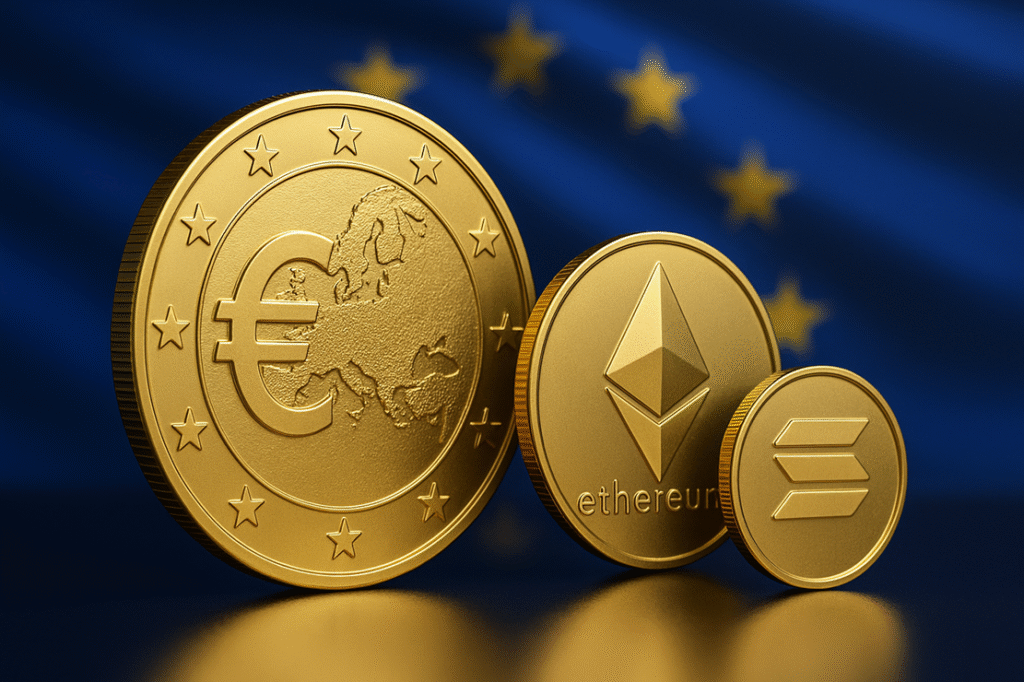As digital currencies continue to reshape the global financial landscape, the European Union is accelerating its exploration of a digital euro. The intriguing development lies in the consideration of deploying this currency on a public blockchain, such as Ethereum or Solana, which signifies a major shift from traditional, tightly controlled financial systems. Driven by the competitive pressure of the expanding cryptocurrency ecosystem and the proliferation of US-led stablecoins, the EU aims to maintain its financial sovereignty and strengthen the euro’s position in the digital realm.
EU’s Move Towards a Blockchain-Based Digital Euro
Understanding the Shift: Public vs. Private Blockchain
For years, the European Central Bank (ECB) has advocated for a controlled environment for the digital euro, focusing on privacy and security within a closed network managed by banks and payment providers. However, the growing influence of dollar-denominated tokens and the recent US stablecoin legislation have prompted EU officials to reconsider their strategy. Embracing a public blockchain could potentially enhance the euro’s reach and integration within the global crypto economy, offering advantages in liquidity and programmability.
ECB Executive Board member Piero Cipollone has highlighted the digital euro as a strategic initiative to decrease European reliance on foreign entities for payments. By embedding the digital euro within a public blockchain, the EU seeks to fortify its financial infrastructure and mitigate the impact of dollar stablecoins on European banks’ profitability. Although the ECB describes the digital euro as a “digital equivalent of cash,” capable of preserving user privacy and ensuring wide acceptance, implementing these goals on a public network presents challenges in maintaining privacy and transaction security.
Potential and Challenges of Public Blockchain Integration
Utilizing public blockchains like Ethereum or Solana offers immediate compatibility with existing cryptocurrency platforms, enabling programmable payments and decentralized finance (DeFi) integrations. Nevertheless, public networks introduce policy challenges, such as ensuring transaction privacy and managing network congestion or outages. Additionally, the open infrastructure necessitates considerations for governance issues, such as protocol upgrades and validator incentives, which may conflict with sovereign control preferences.
Despite these challenges, the EU is closely examining how public networks could support their digital euro initiative without compromising data protection and financial stability. The fundamental question isn’t merely about the technology but also how the digital euro, as a central bank liability, will be legally structured and governed by EU institutions.
The Implications for Ethereum and Solana
Selecting Ethereum or Solana as the platform for a digital euro would not only validate these networks as mature, institutional-grade systems but also position them at the forefront of global token ecosystems. This decision would likely catalyze further development and adoption of these blockchain networks, reinforcing their roles in the financial sector.
At this moment, Ethereum maintains a significant position with its current trading value reflecting its market impact. As discussions continue, the potential inclusion of the euro in the Ethereum or Solana ecosystem would signify a pivotal moment in digital currency evolution.
FAQs
Why is the EU considering a public blockchain for the digital euro?
The EU is weighing public blockchain options such as Ethereum and Solana to leverage their widespread adoption and integration capabilities within the global crypto market. This strategic pivot aims to enhance the euro’s digital footprint and counterbalance the influence of dollar stablecoins.
What are the key challenges of using a public blockchain for the digital euro?
Public blockchains, while offering extensive integration potential, bring challenges in ensuring transaction privacy, managing network-level issues, and navigating governance and regulatory complexities. These factors need careful consideration to maintain financial stability and user data protection.
How does a digital euro differ from stablecoins?
Unlike stablecoins, which are typically backed by reserves and issued by commercial entities, the digital euro would be a central bank liability. This distinction ensures it’s governed by EU institutions, maintaining a legal and regulatory framework that safeguards user interests and financial integrity.
By evaluating both the technological and regulatory landscapes, the EU’s exploration of a blockchain-based digital euro presents a forward-thinking approach to digital currency integration within the global financial system.

